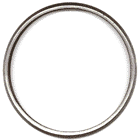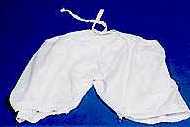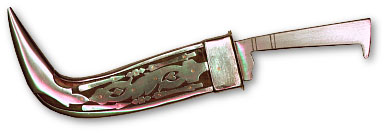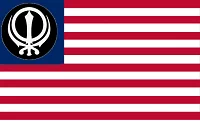THE 5 K’S
The five sacred Sikh symbols prescribed by Guru Gobind Singh are commonly known as Panj Kakars or the ‘Five Ks’ because they start with letter K representing Kakka in the Punjabi language. They are: 1. Kesh or unshorn hair, regarded as a symbol of saintliness. Guru Nanak started the practice of keeping the hair unshorn. The keeping of hair in its natural state is regarded as living in harmony with the will of God, and is a symbol of the Khalsa brotherhood and the Sikh faith. Hair is an integral part of the human body created by God and Sikhism call for its preservation. The shaving or cutting of hair is one of the four taboos or Kurehats. Long unshorn hair. A symbol of spirituality. The Kesh reminds a Khalsa to behave like the Guru’s. It is a mark of dedication and group consciousness, showing a Khalsa’s acceptance of God’s will. Long hair have long been a common element of many spiritual prophets of various religions such as Jesus, Moses and Buddha “represents the inviolability of the human body”. The keeping of unshorn hair represents the Sikh belief in the accepting of God’s will. The unshorn hair is to be covered at all times by the dastar (turban) as a sign of respect for God, and also as a sign of acceptance of the belief in the equality of men and women. Sikhism preaches that the only reason one should cover one’s head is out of respect for God. Since men and women are equal, both men and women must cover their heads, and since God is everywhere, they must do so at all times. The turban also serves as an outward form of recognition of Sikh men and women. From your head down to your toes all hair is to be kept intact.
For the respect of your hair, two turbans are to be tied, tying each layer one at a time. There should be a small turban tied underneath and a larger one tied above this. Women must not plait their hair and should keep their hair tied in a bun. If possible, in order to respect your Kesh then a small turban should be tied.
God also revealed himself as Kesdhari (when God gave Darshan/revealed himself to Sahib Sri Guru Nanak Dev ji he did so in the form of a human with his hair intact), as does the following line narrate:
2. Kangha or the comb is necessary to keep the hair clean and tidy. A Sikh must comb his hair twice a day and tie his turban neatly. The Gurus wore turbans and commanded the Sikhs to wear turbans for the protection of the hair, and promotion of social identity and cohesion. It has thus become an essential part of the Sikh dress. A symbol of hygiene and discipline as opposed to the matted unkept hair of ascetics. A Khalsa is expected to regularly wash and comb their hair as a matter of self discipline.  This is to be worn in the hair at all times, and is used for combing of one’s hair: “it represents hygiene [.] ridding oneself of impurities and what is morally undesirable”. Thus, the kanga reinforces the belief that one would maintain cleanliness of spirit, mind and body. In order to keep the kesh clean a wooden kangha( Sikh Comb ) is to be kept in the hair. According to scientific research keeping a wooden kangha in your hair reduces the level of static energy building up. A metal or ivory comb is not to be used as a substitute.
This is to be worn in the hair at all times, and is used for combing of one’s hair: “it represents hygiene [.] ridding oneself of impurities and what is morally undesirable”. Thus, the kanga reinforces the belief that one would maintain cleanliness of spirit, mind and body. In order to keep the kesh clean a wooden kangha( Sikh Comb ) is to be kept in the hair. According to scientific research keeping a wooden kangha in your hair reduces the level of static energy building up. A metal or ivory comb is not to be used as a substitute.
To keep the hair clean it must be combed twice daily. In the morning and evening after combing your hair a turban is to be tied. It is to be tied a layer at a time, and it is to be removed in the same manner, taking it off a layer at a time.
If your kangha becomes damaged in anyway it should be replaced immediately. The kangha is placed on the head the highest point of the body and thus becomes supreme. In the same way the Khalsa is to become supreme by removing ego and being humble. Just as the kangha removes broken hairs and cleans the hair physically, it is also spiritually questioning the individual as to how many good and bad deeds have been committed during the day. Just as clean hair is attached to your head so are your good deeds. Similarly, as broken hairs are removed by your kangha, your vices should be removed in the same way. The hairs removed by the kangha are not to be thrown in a dirty place or on the floor. They are to be kept in a clean and dry place/container and when enough hair has gathered they are to be burnt. Women and children are to tie a string to their kangha so that it can easily be tied to their hair, and to stop it from falling. At home two to four spare kanghas are to be kept. 3. Kara or the steel bracelet symbolises restrain from evil deeds. It is worn on the right wrist and reminds the Sikh of the vows taken by him, that is, he is a servant of the Guru and should not do anything which may bring shame or disgrace. When he looks at the Kara, he is made to think twice before doing anything evil with his hands.  The circular design of the kara signifies the oneness and eternity of God and “the symbol of perfection [.] a reminder of the wearer to be mindful ofhis role of spiritual aspirant and useful citizen [.] the kara is also on the right side, which is the hand [with which] most people perform their deeds [ and] is a constant reminder to perform good deeds”. By wearing it on the wrist, it binds the wearer to the will of God, and reminds the wearer to never extend one’s hand for the performance of evil. The Kara must be of Sarab Loh (pure iron). The Khalsa is not to wear a kara that is made of gold, silver, brass, copper or one that has grooves in it. Only the Sarab Loh Kara is acceptable to Guru Ji. The Kara is a handcuff placed by the Guru upon the individual to remind us of our duty to God, stopping us from committing sins. The Kara acts as protection if someone goes to strike you with a sword on your wrist. According to scientific research, the Kara adds to the iron levels in the body by rubbing on the skin. The Kara teaches us that these arms belong to Sahib Sri Guru Gobind Singh ji – with which we are not to steal, con, commit forgery, oppress, bully, persecute, sin or murder. Gambling and playing cards and gambling are not permitted. With these hands we should earn an honest living and share its benefits. In addition, your hands should serve your community and the Khalsa nation. The Kara is a precious gift bestowed upon us for life by Guru Sahib, which cannot be separated from the body. The Kara is circular, having no beginning and no end. Similarly, Vaheguru has no beginning or end and the Kara reminds us of this. More on “Kara” 4. Kachh or the soldiers shorts must be worn at all times. It reminds the Sikh of the need for self-restrain over passions and desires. Apart from its moral significance, it ensures briskness during action and freedom of movement at all times. It is a smart dress as compared to the loose dhoti which most Indian wore at that time A symbol signifying self control and chastity
The circular design of the kara signifies the oneness and eternity of God and “the symbol of perfection [.] a reminder of the wearer to be mindful ofhis role of spiritual aspirant and useful citizen [.] the kara is also on the right side, which is the hand [with which] most people perform their deeds [ and] is a constant reminder to perform good deeds”. By wearing it on the wrist, it binds the wearer to the will of God, and reminds the wearer to never extend one’s hand for the performance of evil. The Kara must be of Sarab Loh (pure iron). The Khalsa is not to wear a kara that is made of gold, silver, brass, copper or one that has grooves in it. Only the Sarab Loh Kara is acceptable to Guru Ji. The Kara is a handcuff placed by the Guru upon the individual to remind us of our duty to God, stopping us from committing sins. The Kara acts as protection if someone goes to strike you with a sword on your wrist. According to scientific research, the Kara adds to the iron levels in the body by rubbing on the skin. The Kara teaches us that these arms belong to Sahib Sri Guru Gobind Singh ji – with which we are not to steal, con, commit forgery, oppress, bully, persecute, sin or murder. Gambling and playing cards and gambling are not permitted. With these hands we should earn an honest living and share its benefits. In addition, your hands should serve your community and the Khalsa nation. The Kara is a precious gift bestowed upon us for life by Guru Sahib, which cannot be separated from the body. The Kara is circular, having no beginning and no end. Similarly, Vaheguru has no beginning or end and the Kara reminds us of this. More on “Kara” 4. Kachh or the soldiers shorts must be worn at all times. It reminds the Sikh of the need for self-restrain over passions and desires. Apart from its moral significance, it ensures briskness during action and freedom of movement at all times. It is a smart dress as compared to the loose dhoti which most Indian wore at that time A symbol signifying self control and chastity  Resembling boxer shorts they are designed for comfort and freedom of movement: “.a symbol of restraint of passion, of chastity , and a constant reminder of the prohibition of adultery , both in lusting and in deed”.
Resembling boxer shorts they are designed for comfort and freedom of movement: “.a symbol of restraint of passion, of chastity , and a constant reminder of the prohibition of adultery , both in lusting and in deed”.
The Kashera is the sign of sexual restraint. The Kashera and Kirpan are never to be separated from the body.
You are only to wear Rev Kashera (a traditional style Kashera). The Kashera gives us the teaching,
5. Kirpan or the sword is the emblem of courage and self-defence. It symbolises dignity and self-reliance, the capacity and readiness to always defend the weak and the oppressed. It helps sustain one’s martial spirit and the determination to sacrifice oneself in order to defend truth, oppression and Sikh moral values. A symbol of dignity and the Sikh struggle against injustice. It is worn purely as a religious symbol and not as a weapon. When all other means of self protection fail, the Kirpan can be used to protect yourself or others against the enemy.  This article of faith most closely resembles a sword in a metal sheath and wrapped in a fabric holster . The word Kirpan itself means “mercy, grace, or magnanimity”. The Kirpan is most often worn close to the skin of the body, underneath clothing, and is kept in place by a strap around the shoulder and torso, attached in place by the fabric holster . “While the Kirpan arose of a particular culture and had, at one time, the function of a sword, it long ago lost this aspect, and has become completely spiritualized. It now speaks of law and morality, justice and order, and has become an instrument of the Divine itself’. It represents spiritual power and is never to be used as a weapon. By wearing it on one’s person, it is to remind the wearer to always stand up against injustice. Keeping it close to one’s body also reminds the wearer that he/she is mortal and should make the most of his/her life by helping others and defending justice.
This article of faith most closely resembles a sword in a metal sheath and wrapped in a fabric holster . The word Kirpan itself means “mercy, grace, or magnanimity”. The Kirpan is most often worn close to the skin of the body, underneath clothing, and is kept in place by a strap around the shoulder and torso, attached in place by the fabric holster . “While the Kirpan arose of a particular culture and had, at one time, the function of a sword, it long ago lost this aspect, and has become completely spiritualized. It now speaks of law and morality, justice and order, and has become an instrument of the Divine itself’. It represents spiritual power and is never to be used as a weapon. By wearing it on one’s person, it is to remind the wearer to always stand up against injustice. Keeping it close to one’s body also reminds the wearer that he/she is mortal and should make the most of his/her life by helping others and defending justice.
The Kirpan is there to protect the poor and for self-defence. With patience and mercy, the Kirpan is to be used as a sword in order to destroy oppression. The Kirpan is to always be in a gatra and never to be removed from the body. The Kirpan protects us from hidden and seen enemies. The Kirpan is a weapon to protect the whole body, as a minimum it should be nine inches in length. Keeping the Kirpan in a Kangha, in the Kesh and putting it on a string around the neck like a Janeoo, are against the Rehat and forbidden.
You are never to walk over your Kirpan or other weapons. When washing your Kesh, the Kangha is to be tied to your Kirpan and the Kirpan tied around your waist. When bathing, your Kirpan is to be tied around your head and not tucked into the Kashara as this dishonours your Kirpan and is therefore forbidden. When women bathe they are to tie their dupata on their head and then their Kirpan. When going to sleep your Kirpan is not to be removed from your body. The Kirpan is only to be used for two things. Firstly, to give Guru Ji’s blessing to freshly prepared Karah Prasad or for langar. Secondly, in order to destroy tyrants and oppressors. It must never be used for anythingelse. Sword in Sikhism Very many people question the need of Kirpan or the sword in the atomic age. Others require an explanation for the wearing of the sword. How can sword he reconciled with spirituality ? Even before Guru Gobind Singh Sahib, his grand father Guru Hardgobind had donned the sword as a twin-symbol of temporal and spiritual power(Miri & Piri). He had maintained an army and taken part in military operations against the Mughal forces. Guru Gobind Singh Sahib justified the use of the sword as a duty and as a means of protecting the weak and the oppressed. With human brutes, non-violence is meaningless. Guru Gobind Singh Sahib says: When the affairs are past other remedies, It is justifiable to unsheath the sword. Tyrants are like mad dogs and wolves. They should be opposed in the interests of the good of humanity as a whole. The sword is neither to be used for conquest nor for wreaking vengeance. The sword is meant only for self-defence or for the good of the people. In cases of injustice and intolerance, the refusal to use the sword may do more harm than good. The Sikh’s sword is not an instrument of offence but a symbol of independence, self-respect and power. Guru Gobind Singh Sahib called it Durga or Bhagwati and praises it thus : Sword that smites in a flash, That scatters the armies of the wicked In the great battle-field, 0 symbol of the brave. Your arm is irresistible, your brightness shines forth The splendour of the black dazzles like the sun. Sword, you are the scourge of saints, You are the scourge of the wicked ; Scatterer of sinners, I take refuge with you. Hail to the Creator. Saviour and sustainer, Hail to you : Sword supreme ! The Five K’s, along with the turban, constitute the Khalsa uniform, which distinguishes a Sikh from any other person in the world, and is essential for preserving the life of the community and fostering the Khalsa brotherhood. The Five K’s are not supposed to foster exclusiveness or superiority. They are meant to keep the Sikhs united in the pursuit of the aims and ideals of the Gurus. They enable them to keep their vows made at the time of baptism. The Sikhs have been known to face torture and death rather than cut their hair or remove any of the sacred symbols. The Khalsa cannot be anonymous. His religion is known to all. He stands out among people, and any unseemly behaviour or action on his part would be noted as unbecoming of a follower of the Gurus. People would easily blame him if he deviated from the disciplinary code of Guru Gobind Singh.
